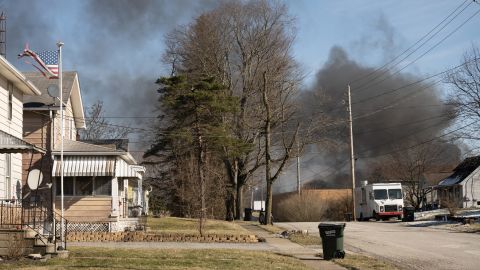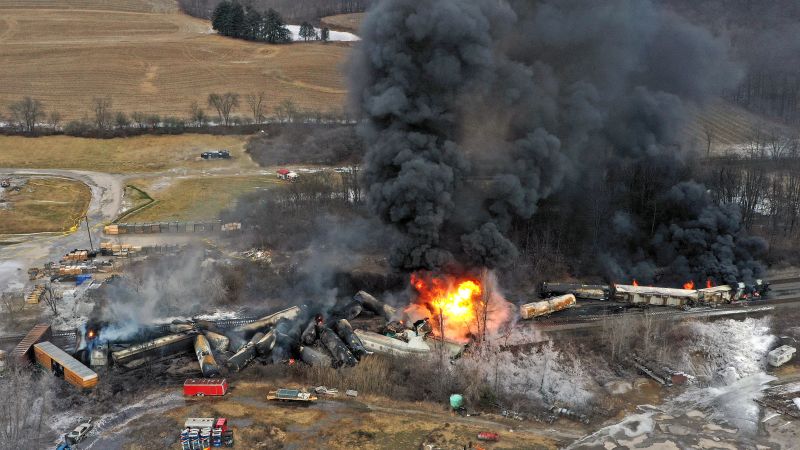CNN
—
Officials are begging residents to leave the area around a burning derailed train in East Palestine, Ohio, where workers are trying to prevent a “catastrophic tanker failure” and explosion that could release toxic gas and shoot deadly shrapnel up to a mile away.
The threat escalated as a massive inferno burned for a third night Sunday from the train carrying hazardous materials. Officials implored those still within a 1-mile radius of the crash site to evacuate immediately as concerns grew about air and water quality.
“There is a high probability of a toxic gas release and or explosion,” Columbiana County Sheriff Brian McLaughlin warned. “Please, for your own safety, remove your families from danger.”
Those who refuse to leave the evacuation zone could be arrested on a misdemeanor charge of misconduct in an emergency, the sheriff posted on Facebook. If there are children in a household that doesn’t evacuate, “further charges of endangering children will apply also,” McLaughlin said.
The scene was so dangerous by Monday morning that the East Palestine Police Department had evacuated a communications center for safety reasons, a spokesperson told CNN by phone Monday. “911 service will not be affected,” the department posted online.
The explosion risk comes from an extreme temperature change inside one of the Norfolk Southern rail cars, warned Gov. Mike DeWine, who on Sunday sent the Ohio National Guard to the scene.
A “drastic change” was detected Sunday in a chemical – vinyl chloride – that officials had been concerned about, Fire Chief Keith Drabick said. Five of the derailed cars were carrying the substance, said the National Transportation Safety Board, which is investigating the disaster.
Breathing high levels of vinyl chloride can make someone die or pass out if they don’t get fresh air, the Ohio Department of Health said. The man-made chemical used to make PVC burns easily at room temperature; can cause dizziness, sleepiness and headaches; and has been linked to an increased risk of cancer in the liver, brain, lungs and blood.

“We are at a risk now of a catastrophic failure of that (train) container. Measures are being taken to try and control that and prevent that from happening,” Drabick said Sunday. “This catastrophic failure, if it occurs, it will produce hydrogen chloride and phosgene gas into the atmosphere.”
“We need you to leave now,” he told some 500 residents who had declined to leave while most of their neighbors evacuated. If there is a blast, the risk radius around the derailment may grow, he added.
While air and water quality remained stable Sunday, “things can change at any moment,” James Justice of the EPA’s Emergency Response warned.
Air and drinking water were safe, East Palestine Mayor Trent Conaway had assured residents. Still, Monday classes at East Palestine schools and city meetings are canceled, he said, and a shelter-in-place order is in effect in the village of roughly 5,000 people near the Pennsylvania border, about 20 miles south of Youngstown, Ohio.
There was a mechanical failure warning before the crash, NTSB Member Michael Graham said Sunday. About 10 of 20 cars carrying hazardous materials – among more than 100 cars in all – derailed, the agency said.
“The crew did receive an alarm from a wayside defect detector shortly before the derailment, indicating a mechanical issue,” Graham said. “Then an emergency brake application initiated.”
Investigators also identified the point of derailment and found video showing “preliminary indications of mechanical issues” on one of the railcar axles, Graham said.
NTSB is still investigating when the potential defect happened and the response from the crew, which included an engineer, conductor and conductor trainee, Graham added.
Investigators have also requested records from Norfolk Southern, including track inspection records, locomotive and railcar inspections and maintenance records, train crew records and qualifications, Graham said.
Rail travel is recognized as the safest method of transporting hazardous materials in the US, according to the US Department of Transportation’s Federal Railroad Administration.
“The vast majority of hazardous materials shipped by rail tank car every year arrive safely and without incident, and railroads generally have an outstanding record in moving shipments of hazardous materials safely,” the administration said.
Since the fire in Ohio is still burning, investigators haven’t been able to walk around the crash site.
It’s unclear how long it’ll take to clean up the scene. “We still have a hot zone in there,” Graham said. He said the preliminary report on the derailment is expected in four to six weeks.
Note:- (Not all news on the site expresses the point of view of the site, but we transmit this news automatically and translate it through programmatic technology on the site and not from a human editor. The content is auto-generated from a syndicated feed.))



